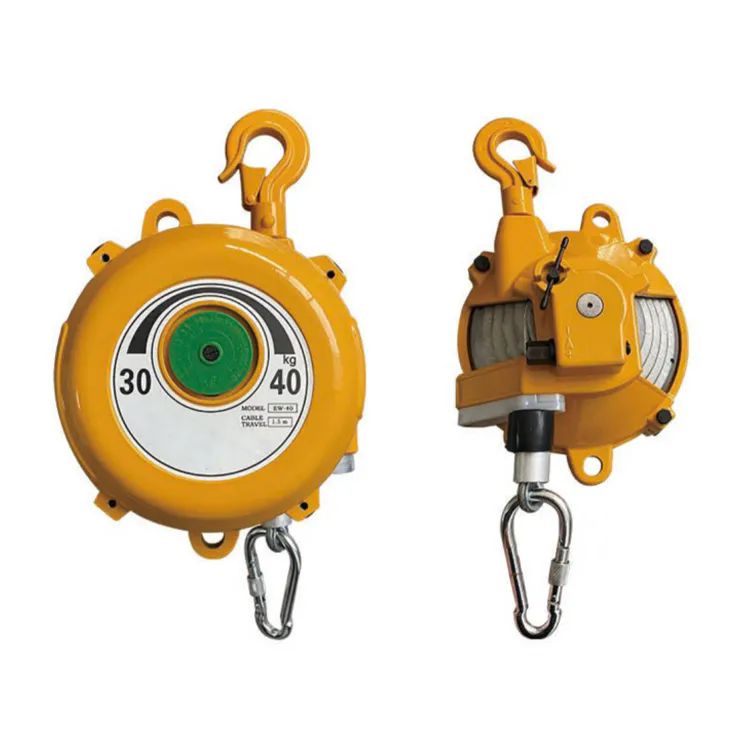Streamline Your Workspace with a Retractable Spring Balancer
2024-09-07
In many industries, efficiency and safety are paramount, especially in environments where tools and heavy equipment are frequently used. One device that significantly contributes to both productivity and worker safety is the Retractable Spring Balancer. This simple yet highly effective tool is designed to make repetitive tasks easier while reducing strain on the operator. In this blog, we’ll explore what a retractable spring balancer is, how it works, and the benefits it offers for various industries.
What is a Retractable Spring Balancer?
A retractable spring balancer is a mechanical device used to suspend tools and equipment in a balanced state, counteracting their weight. This allows the tool to be held at the desired working height, making it feel weightless during use. The spring mechanism inside the balancer retracts the cable when not in use and maintains tension, enabling smooth operation with minimal effort. These devices are commonly used in assembly lines, workshops, and manufacturing environments where workers handle heavy tools for extended periods.
How Does It Work?
The core of the spring balancer lies in its retractable mechanism, which is powered by a coiled spring inside the housing. The balancer is attached to a fixed point above the workstation, and the tool is connected to the retractable cable. As the worker pulls the tool down to use it, the spring tension increases, counteracting the tool's weight. Once the tool is released, the spring retracts the cable, pulling the tool back to its original position. The tension can be adjusted to match the weight of the tool, ensuring a smooth, balanced operation.
Key Benefits of Using a Retractable Spring Balancer
1. Reduced Worker Fatigue
One of the primary advantages of using a spring balancer is the significant reduction in physical strain. Workers who handle heavy or awkward tools can experience fatigue, especially during repetitive tasks. The spring balancer takes on the weight of the tool, allowing operators to use it effortlessly and with precision, leading to better efficiency and less physical wear.
2. Improved Safety
Holding heavy tools for extended periods can increase the risk of injuries, including strains, sprains, and repetitive stress injuries. A retractable spring balancer not only reduces this risk but also keeps the work area organized by suspending the tool in the air when not in use. This prevents tools from being left lying around the workstation, which can be a tripping hazard or lead to accidental damage.
3. Increased Productivity
In addition to improving safety and reducing fatigue, a spring balancer boosts productivity. Workers can move more quickly between tasks because the tool is always within easy reach and requires less effort to operate. The balanced, controlled movement helps workers maintain consistent performance, reducing errors caused by fatigue or tool mishandling.
4. Extended Tool Lifespan
By suspending tools when not in use, a spring balancer can help extend the life of expensive equipment. Tools are less likely to be dropped or mishandled, minimizing wear and tear. Additionally, maintaining a clean and organized workspace helps prevent accidental damage to both tools and surrounding equipment.
5. Versatile Applications
Spring balancers are highly versatile and come in various sizes and weight capacities to suit different tools and tasks. Whether you’re working in an automotive assembly line, an electronics manufacturing plant, or a heavy machinery workshop, a retractable spring balancer can be customized to meet your needs.
Applications of Retractable Spring Balancers
The use of spring balancers spans a wide range of industries:
- Automotive: In car assembly lines, spring balancers help mechanics handle heavy pneumatic tools, reducing fatigue during repetitive tasks.
- Manufacturing: In factories, spring balancers are used to hold tools such as torque wrenches, drills, and welding equipment.
- Workshops: Workshops and garages often use spring balancers to suspend power tools and other equipment, keeping the workspace organized and safe.
- Electronics: In precision industries like electronics, where delicate handling is required, spring balancers support lightweight tools for soldering or assembly tasks.
Conclusion
A retractable spring balancer is more than just a tool holder – it’s a practical solution for enhancing efficiency, improving worker safety, and extending the life of your tools. By eliminating the burden of holding heavy equipment, it allows workers to focus on precision and productivity, leading to better results in less time. Whether you’re managing a large-scale production line or a small workshop, a spring balancer is a valuable investment that can transform your workflow.
Consider incorporating a retractable spring balancer into your workspace to experience the benefits of a more streamlined, efficient, and safe working environment.



